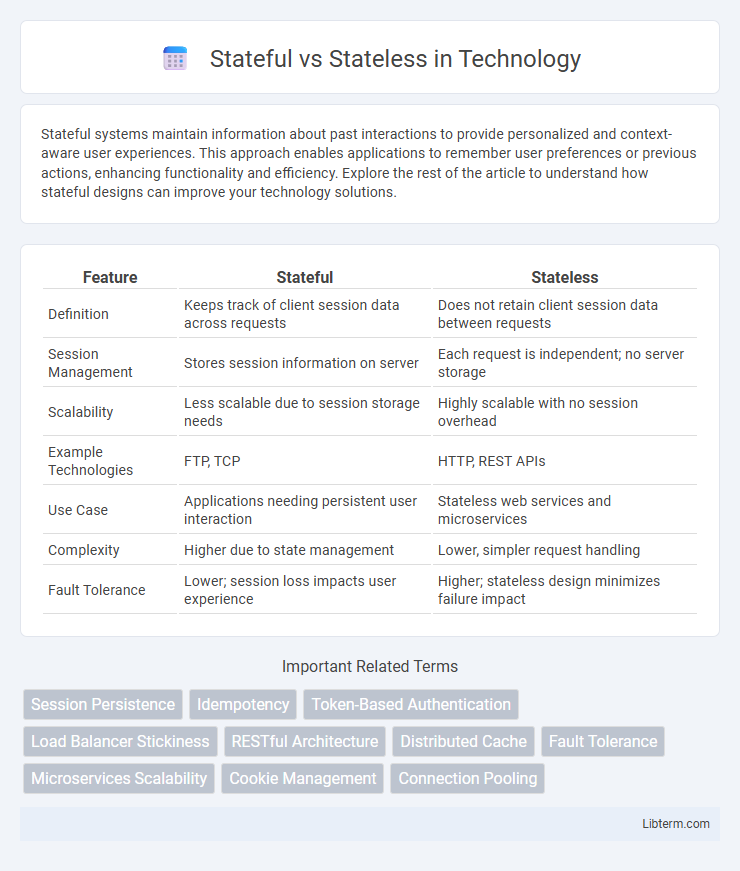Stateful systems maintain information about past interactions to provide personalized and context-aware user experiences. This approach enables applications to remember user preferences or previous actions, enhancing functionality and efficiency. Explore the rest of the article to understand how stateful designs can improve your technology solutions.
Table of Comparison
| Feature | Stateful | Stateless |
|---|---|---|
| Definition | Keeps track of client session data across requests | Does not retain client session data between requests |
| Session Management | Stores session information on server | Each request is independent; no server storage |
| Scalability | Less scalable due to session storage needs | Highly scalable with no session overhead |
| Example Technologies | FTP, TCP | HTTP, REST APIs |
| Use Case | Applications needing persistent user interaction | Stateless web services and microservices |
| Complexity | Higher due to state management | Lower, simpler request handling |
| Fault Tolerance | Lower; session loss impacts user experience | Higher; stateless design minimizes failure impact |
Introduction to Stateful and Stateless Systems
Stateful systems retain information about user interactions and previous transactions, enabling personalized experiences and continuous sessions. Stateless systems treat each request independently without storing data from prior interactions, resulting in simpler, scalable architectures primarily used in RESTful APIs. Understanding the trade-offs between stateful and stateless designs is crucial for optimizing performance, reliability, and resource management in distributed computing environments.
Key Definitions: What Does Stateful Mean?
Stateful systems maintain information about previous interactions or transactions, allowing them to remember user sessions and context between requests. This continuous memory enables personalized responses and efficient management of ongoing processes, such as database connections or user authentication. In contrast, stateless systems treat each request independently, without storing any session data, relying instead on external storage or client-side information to preserve state.
Key Definitions: What Does Stateless Mean?
Stateless refers to systems or protocols that do not retain any session information or history between requests, treating each interaction as an independent transaction. In stateless architecture, every client request contains all necessary information for the server to understand and process it, without relying on stored context. This approach enhances scalability and simplifies server design by eliminating the need for persistent sessions or memory of prior communications.
Core Differences Between Stateful and Stateless
Stateful systems maintain client session information across multiple interactions, enabling context-aware processing and personalized responses. Stateless systems treat each request independently without storing session data, resulting in simpler scalability and reduced server memory usage. Core differences include session persistence, resource consumption, and complexity in managing client-server interactions.
Advantages of Stateful Architectures
Stateful architectures maintain session information, enabling personalized user experiences and efficient resource management through consistent state tracking. This approach enhances application reliability by preserving data context across interactions, reducing the need for repeated data transmission. Stateful systems are particularly advantageous for complex workflows requiring ongoing user engagement and real-time data synchronization.
Advantages of Stateless Architectures
Stateless architectures enhance scalability by handling each request independently without relying on stored session data, enabling easier load balancing and fault tolerance. They simplify server design and reduce resource consumption since no session information needs to be maintained between requests. This approach improves system reliability and supports distributed systems more efficiently by minimizing dependencies on server-side storage.
Common Use Cases for Stateful Systems
Stateful systems retain information about user sessions, making them ideal for applications requiring continuous interaction, such as online banking, shopping carts, and multiplayer gaming platforms. These systems maintain session data to provide personalized experiences and ensure data consistency throughout user interactions. Stateful designs are crucial in scenarios demanding real-time updates and persistent connections, like video conferencing and collaborative work tools.
Common Use Cases for Stateless Systems
Stateless systems excel in common use cases such as RESTful APIs, web servers, and microservices where each request is independent and does not rely on stored session data, enabling scalability and fault tolerance. These systems facilitate load balancing by allowing any server to handle incoming requests without synchronization overhead. Stateless architectures also simplify caching strategies and improve recovery time, making them ideal for cloud-native applications and distributed environments.
Performance and Scalability Considerations
Stateful systems maintain session information across requests, which can increase resource consumption and reduce scalability due to the overhead of storing and managing state data. Stateless systems improve performance and scalability by treating each request independently, allowing easier load balancing and horizontal scaling without session affinity. Cloud-native and microservices architectures commonly adopt stateless designs to optimize resource utilization and handle large volumes of concurrent users efficiently.
Choosing the Right Approach: Stateful vs Stateless
Choosing between stateful and stateless architectures depends on application requirements such as scalability, session management, and fault tolerance. Stateful systems maintain client context, offering enhanced user experience but can complicate scaling and recovery, while stateless systems treat each request independently, promoting easier scalability and resilience. Evaluating factors like session persistence needs, resource overhead, and system complexity guides selecting the optimal approach for performance and reliability.
Stateful Infographic

 libterm.com
libterm.com